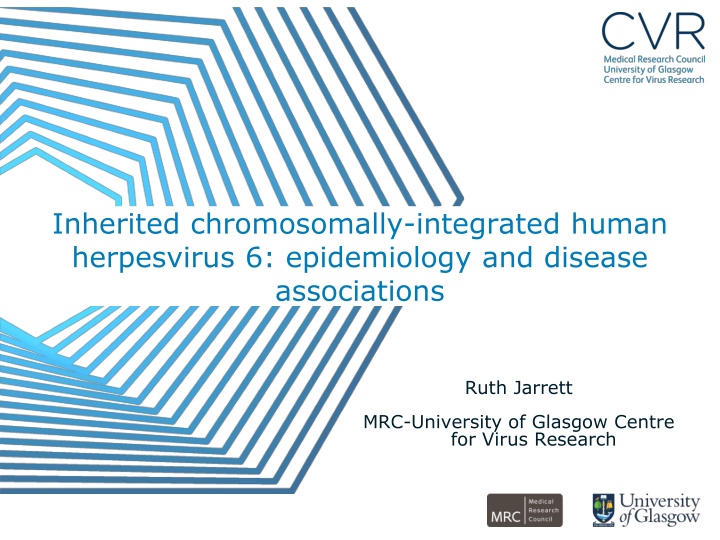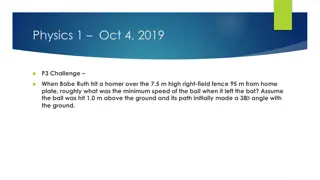
The Epidemiology and Disease Associations of Integrated Human Herpesvirus 6
Explore the epidemiology and disease associations of chromosomally integrated human herpesvirus 6 (HHV-6), including its integration into telomeres, excision, and potential consequences like viral reactivation, age-related diseases, and cancer risk.
Download Presentation

Please find below an Image/Link to download the presentation.
The content on the website is provided AS IS for your information and personal use only. It may not be sold, licensed, or shared on other websites without obtaining consent from the author. If you encounter any issues during the download, it is possible that the publisher has removed the file from their server.
You are allowed to download the files provided on this website for personal or commercial use, subject to the condition that they are used lawfully. All files are the property of their respective owners.
The content on the website is provided AS IS for your information and personal use only. It may not be sold, licensed, or shared on other websites without obtaining consent from the author.
E N D
Presentation Transcript
Inherited chromosomally-integrated human herpesvirus 6: epidemiology and disease associations Ruth Jarrett MRC-University of Glasgow Centre for Virus Research
Human herpesvirus 6 Two distinct but closely related herpesviruses HHV-6A and HHV-6B Most individuals are infected in early childhood Virus persists for life and can be reactivated HHV-6B more prevalent in Europe, the USA and Japan HHV-6A relatively more common in Africa?
HHV-6 and disease Primary infection by HHV-6B causes roseola infantum and common cause of febrile seizures Reactivation rarely problematic in immunocompetent individuals In immunosuppressed individuals reactivation is associated with encephalitis, colitis, hepatitis etc. Many other associations mesial temporal lobe epilepsy, MS, myocarditis and cardiomyopathy, low Bayley scores reported but not proven
HHV-6 integrates into telomeres Direct repeat (DR) Unique region Direct repeat (DR) Perfect and imperfect telomere-like repeats Perfect and imperfect telomere-like repeats Host telomere Homologous recombination 162 kb of herpesvirus genome integrated in telomere
Integrated HHV-6 can be excised Chromosomally integrated HHV-6 can reactivate in vivo Excised viral genomes detected in vitro Chromosomally integrated HHV-6 may be a form of latent viral infection
Exogenous HHV-6 infection Inherited HHV-6 (iciHHV-6) HHV-6 DNA HHV-6 DNA ? Heritable Non-heritable
Viral Inflammation reactivation Drugs HDAC inhibitors Sudden telomere shortening Senescence Telomere fusion Altered cellular gene expression Chromosome- specific Influence on expression of sub-telomeric genes
Inherited HHV-6 (iciHHV-6) HHV-6 DNA Consequences of iciHHV-6? Viral reactivation Age-related disease Cancer Heritable
iciHHV-6 in GS:SFHS: Aims To explore clinical relevance To determine the prevalence of iciHHV-6 in a large population-based study determine whether HHV-6A or HHV-6B To determine whether chromosomal integration is random To analyse viral evolution evidence of new integrations timing of integration events
Detection of iciHHV-6 in the GS:SFHS TaqMan screen HHV-6 DR1/ -globin ddPCR HHV-6B DR6 RPP30 ddPCR HHV-6 U7 RPP30 TaqMan HHV-6A pol TaqMan HHV-6B pol If negative ddPCR HHV-6A DR6
Conclusions Analysis of iciHHV-6 in the GS:SFHS has uncovered some unexpected findings Regional differences in the iciHHV-6 prevalence in the UK were detected iciHHV-6 is associated with an increased risk of some disease symptoms
Acknowledgements University of Glasgow CVR Adam Bell Chris Brownlie Skye Storrie Andrew Davison Rob Gifford Archie Campbell Caroline Hayward Carmen Amador Shona Kerr Pamela Linksted David J Porteous Blair H Smith Lynne Hocking Sandosh Padmanabhan ICAMS Christian Delles Barts Health NHS Trust Duncan Clark Edinburgh Clinical Research Facility Lee Murphy Angie Fawkes BGS, ICR Anthony Swerdlow Nick Orr





















